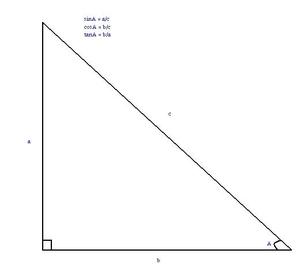The Pythagorean theorem, special right triangles, trigonometric functions sine, cosine, tangent, law of sines, and law of cosines can be overwhelming to students in geometry and trigonometry. This article will be a clear, concise guide for all of these topics involving triangles.
A triangle is a 3-sided geometric figure, whose sides are line segments, with 3 angles and 3 vertices. The sum of the measures of the angles of a triangle is 180 degrees.
Right triangle
A triangle with a 90 degree angle is a right triangle. The lengths of a sides of a right triangle can be found by using the Pythagorean theorem, given the length of two of the three sides. If a, b, and c are the sides of a right triangle, with c being the hypotenuse, then a2 + b2 = c2. If the lengths of the sides of a right triangle are known, the measures of the two acute angles can be found using trigonometric functions. Sine of an angle is the opposite side divided by the hypotenuse. Cosine of an angle is the adjacent side divided by the hypotenuse and tangent of an angle is the opposite side divided by the adjacent side.
Special right triangles
The 2 special right triangles where the Pythagorean theorem is not needed are the 45-45-90 right triangle and the 30-60-90 right triangle. The 45-45-90 right triangle has 2 angles of 45 degrees and a 90 degree angle. In this case the hypotenuse is the square root of 2 times the length of a side. Both sides are the same length. If the length of the hypotenuse is given, the length of each other side is obtained by dividing by the square root of 2.
In the 30-60-90 right triangle, there is a 30 degree angle, a 60 degree angle, and a 90 degree angle. The length of the hypotenuse is twice the length of the shortest side of the triangle (side opposite the 30 degree angle) and the length of the longer side (side opposite the 60 degree angle) is the square root of 3 times the shorter side.
Other types of triangles
- Isosceles: A triangle with two sides of equal length.
- Equilateral: A triangle with the lengths of all three sides equal. That is also an equiangular triangle, with all 3 angles of equal measure.
- Scalene: A triangle with no sides of equal length.
- Obtuse: A triangle with one angle measuring greater than 90 degrees.
- Acute: A triangle with all angles measuring less than 90 degrees.
Law of sines and law of cosines
To obtain the lengths of the sides of a triangle with no right angles, trigonometry will be used. The Law of Sines and the Law of Cosines are 2 such methods used. The Law of Sines is SineA/a = SineB/b = SineC/c which A,B and C representing the angles of the triangle and a,b and c representing the sides of the triangle. Use the law of sines when given a side and two angles, two angles and the included side, or two sides and opposite angle.
Use the law of cosines when given two sides and included angle or all three sides. The law of cosines is a2 = b2 + c2 – 2bcCosine(A) (or equivalently b2 = a2 + c2 – 2acCosine(B) and c2 = a2 + b2 – 2abCosine(C)).
This information assists anyone who needs to know the basics about triangles and who need more in depth information on finding angles and sides of the various types of triangles.







